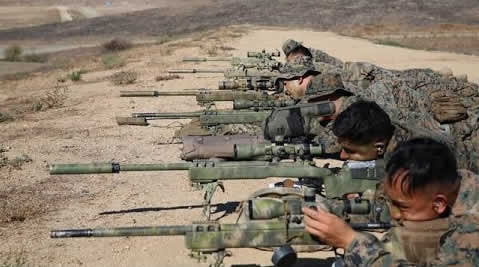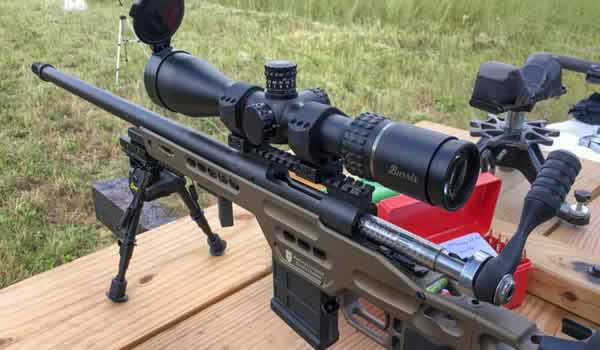
All Hail the King of 2 Miles
Three-day long-range shooting match in New Mexico tests those who would target the throne of the King of 2 Miles.
Everyone who has gotten into long-range shooting knows what it’s like to keep going farther in distance. We all remember that magical moment when you pull the trigger, wait, watch the bullet impact the target, wait again, and the sound returns back to you.
There is nothing like pushing the envelope once you’ve got your basics down. Playing at extreme ranges is nothing new, but now competitions
are really taking notice and popping up across the nation and the world!
You will see them in various forms, but the one that is thought of as the “Super Bowl” of Extreme Long Range (ELR) is the King of 2 Miles competition held at the renowned NRA Whittington Center in Raton, New Mexico.

KO2M is a three-day match featuring some of the world’s best ELR
shooters, who specialize in disciplines such as precision rifle, high power, “across the course” and .50-caliber benchrest shooting. This year’s match, to be held June 29 through July 1, will include around 80 participants.
The match setup is as follows: Five targets on two courses of fire. Shooters get three rounds per target, except for the first target where they get five.
The match starts off with a cold-bore round. It’s just you and your rifle laying down looking across a canyon and you’re 1,550 yards away from your first target! It’s now go time with no alibis! If you make an impact on the first target within the allotted round count and time, it will unlock the chance to engage the next target that spans another 1,300 yards farther at various angles. Target distances on the qualifying run go from 1,550 to 2,700 yards.

It’s a hit-to-advance elimination-type match. If you don’t impact the target within your allotted rounds, you are done with the match. The scores are to reward first-round hits and getting on target as quickly as possible. If you get three attempts, the yardage has always been the point total by attempt. So if the target is 1,500 yards away, the first shot is worth 1,500 x 3 for 4,500 points. The second shot is worth 1,500 x 2 for 3,000 points, and the final shot is worth 1,500 x 1.
On top of that, all of this has to happen within a seven-minute par time as well. That seven minutes is for all 16 rounds, including a bonus sub-MOA cold-bore target attempt that is used to start your time.
This is a very unforgiving format, but one that encourages you to have your ducks in a row rather than the “walk them in” method.
AFTER THE FIRST two days of qualifying, organizers take the top 10 shooters and put them in their own mini-match under the same format, except the ranges span from 2,700 to 3,520 yards (2 miles). This is the final round used to determine the winner and the placement for the competitors. The only difference here is you are allowed to use rounds allotted for future targets to “buy in” to impact a target.
For example, you have a total of 15 rounds to attempt going five-for-five at the three ELR targets. If you miss all five shots, you can keep pulling from the 15 rounds until you get a hit on that target. If you impact on the sixth shot, you won’t get points for that because it wasn’t in the allotted round count, but you are able to proceed to the next target with five attempts given to you, granted that you have enough rounds to complete the course of fire.
You can’t hold an event like this just anywhere. It takes a few resources to host these competitors and certain features make it more manageable and entertaining. First off, you’re shooting off an elevated firing line so that mirage can be kept to a minimum. Second, you’re shooting at a target just off a cliff face or some sort of terrain feature that shows you a lot of your misses. Third, you are at an elevation suitable for ELR shooting. The firing line is roughly 6,600 feet above sea level, if I remember correctly.
Combined, these make for a great time to stretch out your rifle under a competition format. Calling hits and misses at extreme long range can be difficult under good conditions and the KO2M crew has that covered as well. A high-tech camera system that wirelessly gives live video feedback to many monitors with multiple viewers makes calling hits and misses a breeze. If you hear the bell ring, then you know someone just hit the target.

AT LAST YEAR’S event, my team at Manners Composite Stocks took first place out of more than 60 shooters. Each competitor gets to assemble a three-man team, including a wind coach and spotter. One reads wind changes and the other assists with where the shots went. Together with my teammates Tom Manners and Andrew Shaver, we hit more targets
than any previous winner and had a phenomenal run. We only missed one
shot on the qualifying run. Everything else was first-round impacts with all the follow-up.
As my team’s shooter, the challenge for me was doing something out of
my level of experience. I have played with ELR by cartridge, meaning
stretching smaller rounds past their normal capabilities, but never had
the means to do it with these types of rifles and cartridges. I took the same mindset and applied it to this: Don’t overthink anything, just look at it the same, and let the larger, more efficient rounds do the work.
This is an event that attracts riflemen spanning multiple disciplines
and that’s what makes it so attractive to me. Every time I have attended, I have learned something new because I was interacting with people outside my normal circle.
You will find teams from various countries competing at the highest levels, from F-Class, Benchrest and ELR, among many others, and some from my discipline, which is practical precision rifle. It’s very cool
to see guys who do well within their realm change up their style and gear to compete under a standardized set of rules with cartridges and weapons that allow for repeated impacts at extended distances. The list of gear used is enormous, as everyone does something a bit different and has their own strategy.
The King of 2 Mile match is a fun learning experience and I intend to do
it again. We are working on new rifles to have ready before the match. It is exciting to blend your normal match gear with much larger components and go dent some primers with the best ELR shooters on the planet. Drawing shooters from different backgrounds and strategies and with industry support backing them to drive the sport makes for an interesting climate for long-range precision.
I have been very fortunate to get support from many of my favorite companies in the industry, including GA Precision, Bartlein Barrels, RCBS Reloading, Hornady, and Bushnell Optics, to name a few. I really enjoy going out to represent all of the companies and see what we can do. This year we are going to use the same gear with a slightly different cartridge we designed. I’m taking the same scope on the same mount and going to a BAT ES action screwed to a Bartlein Barrel by GA Precision. We plan on launching Cutting Edge Bullets under predictions based off the Hornady 4DOF solver. Trigger Tech sent me an awesome trigger with a crown engraved on it, so I suppose that would be a great bang switch for the platform.
I can’t wait to see next year’s competitors and see how the format will go. I think we will see a few more PRS shooters enter the game and I think they will do well. The style will align well with an easy transition – just a bit more recoil and longer time of flights. If you want some excitement, there are ELR matches popping up across the country and it’s getting much more popular. No, you don’t have to go crazy, as many think.
Start stretching out your gear to find your limitations and learn things that will let you go farther. It’s such a blast to fire your rifle and wait a while for a bullet to impact a target. It doesn’t get much better than that for me. Getting out with shooters and conditions will show you your errors and how to improve. After all, that’s the golden rule in precision rifle – knocking out any variables you may have and trying to achieve perfect consistency.
Be sure to check out American Shooting Journal’s August issue to find out the results of this year’s King of 2 Miles competition.
STORY BY ROBERT BRANTLEY • PHOTOS © SNIPER’S HIDE



